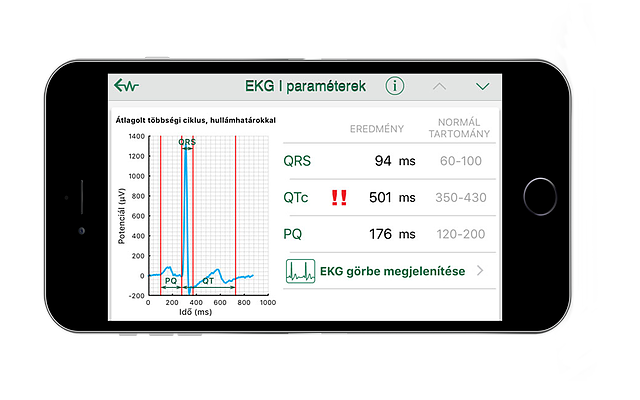
Detection
- ECG irregularities
- Arrhythmia
- Increased stroke risk (atrial fibrillation)
- Increased risk for sudden cardiac arrest (based on ventricular heterogeneity – an indication for ventricular tachycardia/fibrillation)
- Oxygen deficiency
Cooperation
- Encouraging patients to self-monitor and cooperate
- Supporting a healthy lifestyle
- Storing assessment results on your smart device
- Results can be shared via email as PDF
Rationalize
- Rationalizing the number of patient-doctor meetings
- High-res ECG curve
- Immediate assessment
- Measurement without the presence of a doctor, just when the
- symptoms occur
Recommended by specialists
„I recommend it not only for my patients living with a heart disease but for my health-conscious patients too”

„We were the first to test WIWE on both healthy people and patients with known history. Its algorithm is such that it draws the user’s attention to the possibility of problems without medical examination”
Prof. Dr. Béla Merkely, SOTE

„What I love about WIWE is that I can take a recording even if my smartphone is not on me or if I don’t know how to use a smartphone and I can sync the results later”
Dr. Bertalan Meskó, The Medical Futurist

„I’ve been so impressed with WIWE that we decided that we’re going to roll out a pilot-project amongst a sample population of patients we want to monitor. I’m absolutely confident that WIWE’s going to make a tremendous difference in the quality of care we offer our patients while at the same time reducing the cost of doing that”
Prof. Rubin Pillay, USA
WIWE ECG can help you the following ways
ECG wave analysis
- Evaluation of ECG parameters: PQ, QRS, QTc
- Evaluation of ventricular activation
- Information about possible irregularities in cardiac conduction
- Patient pre-screening
Arrhythmia detection
- Detection of frequent extra beats
- Examination of heart-rate flactuation
- AF detection: stroke risk factor
Patient monitoring
- Results can be emailed to doctor
- ECG parameters, risk levels
- Entire ECG recording can be emailed
- Remote diagnosis
Sudden cardiac arrest
- Following tendencies
- Ventricular heterogeneity assessment
- Assessment of the bioelectrical stability of the cardiac muscle
- Risk assessment for ventricular fibrillation/tachycardia

ECG
ECG assessment using a unique, intelligent algorithm: parameters are based on the recorded lead I. wave’s average majority cícle (QRS, QTc, PQ). Highly advanced mobile ECG technology that facilitates the reliable examination of the low-amplitude P wave
AR/AF Arrhytmia / Atrial fibrillation

ECG assessment using a unique, intelligent algorithm: parameters are based on the recorded lead I. wave’s average majority cícle (QRS, QTc, PQ). Highly advanced mobile ECG technology that facilitates the reliable examination of the low-amplitude P wave

VT/VF Prerequisite of ventricular tachycardia/fibrillation
Increased heterogeneity (electrical instability) of ventricular cardiac cells increases the probability of malignant arrhythmias (ventricular tachycardia, ventricular fibrillation), which may lead to sudden cardiac arrest.
Ventricular heterogeneity shows the discrepancy in the bioelectric characteristics of the cardiac cells constituting the ventricular myocardium. This discrepancy may also be present under healthy conditions in a deterministic form (quasi-rigid connection between the cells). In case of pathological condition the heterogeneity may be enhanced and the harmonized functioning of cardiomyocytes tends to get worse, which means that a random fluctuation and significant instability in the bioelectric phenomena can be detected. This kind of instability will increase the risk of malignant ventricular arrhythmia, and thus the risk of sudden cardiac arrest.
On the graph you can see the evaluation of the Ventricular Heterogeneity which gets calculated based on two parameter: the average ventricular heterogeneity and the deviation of the ventricular heterogeneity. The different colored zones represent the areas in which the results can be classified into.
In a world-unique way risk assessment of the malignant ventricular arrhythmia (tachycardia/fibrillation) is based on the QRST intgral
WIWE ECG can help you the following ways

- Two electrode ECG with the accuracy of lead I. of the clinical ECG device and it also has clinical testing background (study)
- CE approved mobile ECG and algorithm to detect atrial fibrillation instantly
- CE approved algorithm that evaluates ECG with 98.69% accuracy
Check-up with the push of a button:
- ECG recordings and evaluation between patient visits
- Monitoring several parameters with one device (ECG, blood oxygen level, heart rate, physical activity)
- Recording various conditions
Closer cooperation higher quality care
- Patients can record clinical-grade ECG anytime, anywhere
- Outstanding cooperation and satisfaction compared to the traditional method
- Your patients have a deeper understanding of the treatment and they feel more inspired to cooperate with you
Smart application smart decisions
- Easy-to-use application for easy workflow
- Trends are easy to follow from the patient’s health journal
- Automatic risk assessment
- Results can be printed and cataloged from PDF
Possibility for cloud integration
- Real-time monitoring and risk assessment
- Monitoring anytime, anywhere
- Monitor tendencies
- Patient results are accessible anytime, anywhere


